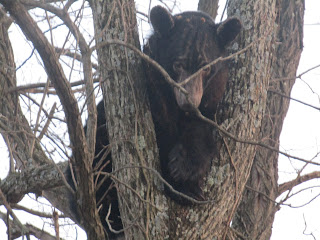In this tree, so close to home....
was this bear. In January. We wondered why it wasn't hibernating and why it was hanging out so close to our homes in spite of the barking dogs and playful childrens' shrieks and laughter.
The answer may lie in the fact that he appeared rather unwell and a bit mangy.
The Game Warden was called and advised our neighborhood to watch for it and report any sightings. They hope to capture it and hopefully treat it so that it won't spread the disease among the local wildlife.
A little research turned up this,
'Animals with sarcoptic mange will often exhibit hair thinning and loss. The skin becomes thickened, wrinkled, and covered in scabs and foul-smelling crusts due to overgrowths of normally occurring bacteria and yeasts. Skin lesions can involve the entire body however the ears and face are most commonly affected. Severely affected animals may become emaciated, depressed, and lethargic, and may lose their fear of man. When the skin around the eyes, mouth, and ears is involved, animals may experience blindness, difficulty eating, and hearing loss. Red foxes are typically the most severely affected wild species and often die of this disease. Severely affected bears will often not den.'
That may explain a few things.






